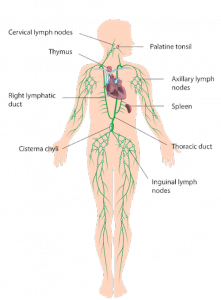WEDNESDAY, 14 OCTOBER 2015
Now for more news from Nature Neuroscience! For the first time, researchers have found lymph vessels – an important part of the immune system – surrounding the brain. This links the brain and immune system more closely than ever before, and could affect how we treat anything from neuroinflammation to psychiatric disorders.To understand this discovery, we first need to understand circulation in the brain and body. The brain is supplied by small blood vessels, which also contain specialised molecular structures in their walls collectively called the ‘blood-brain barrier’. Their function is to keep pathogens and toxins out of the brain, while regulating nutrient delivery and waste removal. Circulation in the body, in contrast, is done by both blood and lymph vessels. The fluid in lymph vessels circulates passively when we move (unlike blood, it’s not pumped by the heart). The lymphatic system helps control fluid balance in the body, as well as immune surveillance and response. Many types of immune cells, including the aptly-named lymphocytes, circulate in lymphatic vessels and proliferate in structures called lymph nodes before attacking invaders.
 The human lymphatic system.
The human lymphatic system.Neuroscientists already knew that immune cells could come into contact with the central nervous system, but did not fully understand how these cells – which are produced and ‘trained’ elsewhere in the body – could get in or out without functioning lymph vessels. Loveau and colleagues discovered brain lymph vessels through a careful anatomical study of mouse meninges, the membranes surrounding brain & spinal cord. The small vessels they found on the interior surface of the dura (the tough outer membrane) had not only the same chemical markers as lymph vessels elsewhere in the body, but also a direct physical link to lymph nodes in the neck.
As far as the researchers know, there is no ‘lymph-brain-barrier’. This means that what goes into the lymph could have a greater tendency to come out into the brain than what goes into the blood. So disorders elsewhere in the body – particularly immune conditions & cancers – could affect the brain even more than we already think. One example is metastatic brain cancer, where cancer cells reach the brain from tumours in different parts of the body. Since cancer cells move around in both the lymph and the bloodstream, brain lymph vessels could be a previously unknown ‘highway’ for brain cancers, and a new focus for therapy. Recently, psychological disorders like depression have also been linked with immune function; the direct lymphatic link between the brain and immune system adds another level of complexity to this relationship. So look after your lymph!
Nature Neuroscience article: http://www.ncbi.nlm.nih.gov/pubmed/26030524
Explanation of blood-brain-barrier: http://neuroscience.uth.tmc.edu/s4/chapter11.html
Review of links between immune activity & depression: http://www.ncbi.nlm.nih.gov/pmc/articles/PMC2919277/
